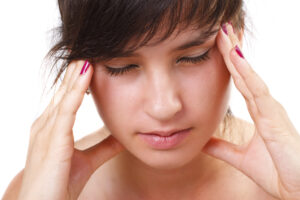Headaches (HA) can significantly alter a person’s quality of life. Moreover, they can interfere and sometimes even prevent an individual from performing important activities such as going to work, attending school, or participating in group activities such as sports, music programs, holiday gatherings, and more. The focus of this month’s Health Update is on Tension-Type Headaches (TTH), a common “primary headache” with tremendous socioeconomic impact.

Contact Dr. Dohoney if you have chronic headaches.
Compared with migraine headaches, tension-type headaches are actually more common and can be equally as disabling. A recent study reviewing popular treatment approaches for TTH reported that establishing an accurate diagnosis is important prior to beginning treatment and finding “…non-drug management is crucial.” Recommendations regarding treatment also include becoming educated about TTH, obtaining reassurance, and identifying trigger factors that can precipitate a TTH. Psychological treatments with scientifically-proven benefit include relaxation training, EMG biofeedback, and “cognitive-behavioral therapy” (CBT). Physical therapy, chiropractic, and acupuncture are widely used, but further research supporting these approaches is needed. The researchers state “simple analgesics” are the primary drug choice for TTH, but they strongly oppose the use of combination analgesics, triptans, muscle relaxants, and opioids, “….and it is crucial to avoid frequent and excessive use of simple analgesics to prevent the development of medication-overuse headache.” They state that the tricyclic antidepressant amitriptyline is “drug of first choice” when treating chronic TTH, but they point out side effects can be significant, thus hampering their use. The researchers conclude that the treatment of frequent TTH is often difficult, and multidisciplinary approaches can be helpful. THIS IS WHERE CHIROPRACTIC FITS IN! These researchers state that non-drug approaches as well as medications “…with higher efficacy and fewer side effects [are] urgently needed.” They advise that future studies need to focus on optimizing treatment programs to best suit the individual patient utilizing psychological, physical, and pharmacological-treatment approaches.
So, what can chiropractic bring to the table in this “team” treatment approach? First of all, it is non-drug oriented, the need of which clearly was emphasized in this study. Second, the presence of muscle tension at the base of the skull/top of the neck can be addressed VERY SPECIFICALLY with spinal manipulation of the cervical spine, active release, myofascial release, trigger point therapy, manual cervical traction, and more! Third, the use of NON-PRESCRIPTION nutrients such as ginger, tumeric, boswellia, Bromelain, white willow bark, fish oil/omega-3 fatty acids are all non-drug (with fewer potential side effects) options that facilitate in controlling inflammation. Using a home cervical traction device can also be VERY HELPFUL! Specific exercise training aimed at muscle relaxation, stretching, and strengthening (especially the deep neck flexors) can ALL BE MANAGED by a doctor of chiropractic!!!
We realize you have a choice in whom you consider for your health care provision and we sincerely appreciate your trust in choosing our service for those needs. If you, a friend, or family member requires care for headaches, we would be honored to render our services.
Content Courtesy of Chiro-Trust.org. All Rights Reserved. To see Dr. Dohoney’s full blog page, please visit www.drstephendohoney.com.